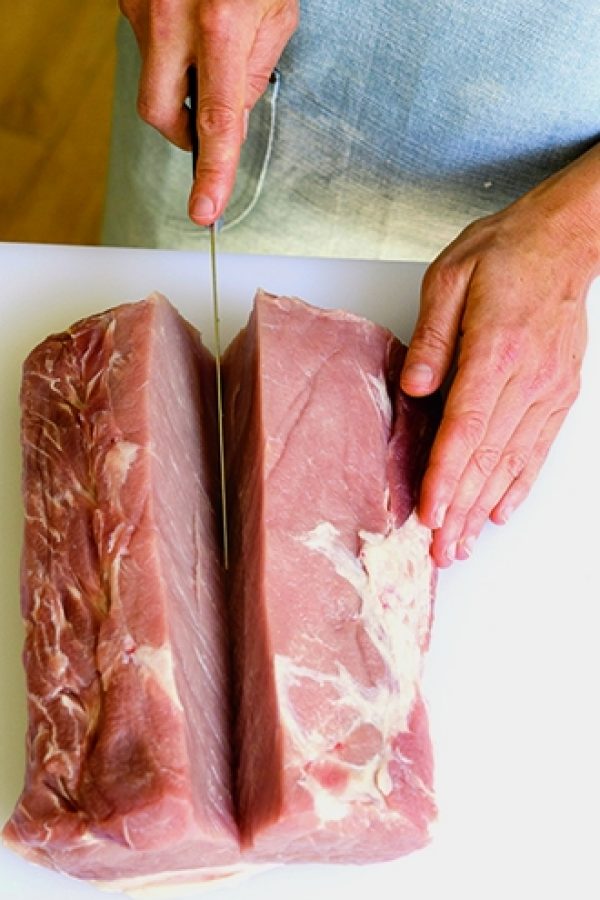In search of a fresh holiday roast, we looked to South America, where we found a solution that transforms a challenging cut of meat into an impressive, robustly flavored centerpiece.
In Argentina and Uruguay, the most prized cuts of beef were historically sent off to prosperous cities, leaving behind the cheapest, least desirable cuts—including a long, thin, extremely tough piece of meat taken from near the upper ribs and skin. The cut is known as matambre, an amalgam of the Spanish words “matar” and “hambre” that translates to “hunger killer.”
Farmhands employed various techniques to make matambre palatable: salting it, pounding it, even soaking it in milk overnight to tenderize the meat. Then they would line the beef with raw vegetables, fresh herbs and spices, roll it up into a stuffed cylinder and cook it until tender. The result, once sliced, is as deliciously layered as it is visually striking: a colorful, well-seasoned pinwheel of just-cooked vegetables, bright herbs and tender meat.
Matambre arrollado or relleno (rolled or stuffed) has countless variations: grilled, roasted, even poached; stuffed with everything from carrots, peppers and tomatoes to hard-cooked eggs, olives, sliced deli meat, parsley and oregano. Traditionally served chilled and sliced, like a cold cut, it’s one of the highlights of a typical Christmas Eve dinner—which happens at the height of South America’s summer—but restaurants also sell slices year-round as an appetizer.
At Milk Street, we loved the variety of flavors and textures that matambre arrollado presented, but we stumbled when it came to the process—and protein. We started out using flank steak, the closest approximation to matambre, but butterflying the already-thin cut proved tricky. Then we considered beef tenderloin, a pricey cut that is far easier to butterfly—but it also doesn’t pack much inherent flavor and wouldn’t give us the same contrasting texture with the filling.
Upon doing more research, we learned that the arrollado technique is often applied to chicken, pork and even rabbit—expanding our options. We ultimately settled on boneless pork loin, which was not only more affordable but easier to butterfly (see the step-by-step instructions). Once cut and unrolled, the loin had more surface area for applying filling. And the pork was more forgiving than flank steak when roasted, retaining more moisture during its long cook time.
With our choice of meat settled, we tackled flavoring. First, we seasoned both sides of the pork with a blend of cumin, coriander and brown sugar, which would promote browning. Then we moved on to the herbs. Instead of rolling fresh herbs and greens into the meat, we made a garlicky, bright green chimichurri sauce—another South American hallmark—to slather on the inside of the butterflied roast. (We reserved some of the sauce for spooning onto slices of the finished dish.) Parsley, oregano, garlic, red wine vinegar and olive oil whirred in a food processor for about 1 minute and the chimichurri was done.
For the pork loin’s filling, traditional recipes call for batons of peppers and carrots. But we found the raw vegetables offered little sweetness (and required extra knifework). So we maximized the flavor by choosing bolder ingredients: savory capicola, sweet roasted red peppers, briny olives and hard-cooked eggs for surprising creaminess. We layered each on top of the butterflied pork, adding a light layer of panko as a binder, then rolled everything into a tight cylinder.
After a couple hours in a 350°F oven, the roast was deliciously golden brown and, once sliced, had the impressively colorful pinwheel presentation of a classic matambre. Not only was the pork loin easier to assemble, with a reliably tender texture, but its sweetness also complemented the flavors in our tangy chimichurri, which we served on the side. In addition to producing a fresh, powerfully flavorful take on a holiday roast, we managed to make a complex dish more approachable but no less delicious.
Prepare the Pork

Position the roast on a cutting board with a short end facing you. Make a lengthwise cut, stopping about ½ inch from cutting all the way through the roast.

With the knife blade parallel to the cutting board, make small incisions into the meat, slicing lengthwise and opening the loin like a book as you slice.

Rotate the roast 180 degrees to cut the second side, then repeat the cutting and opening up to create a large, flat piece of meat with an even surface.

If there are spots in the meat that are thicker than desired, use a meat mallet to pound those spots to the same thickness—roughly 1/2 to 3/4 inch thick.
Stuff the Pork

After brushing the chimichurri over the meat, layer the capicola, olives, peppers and panko on the pork. Line up the egg halves 3 inches from the edge.

Using both hands, roll the edge of the meat up over the eggs, pressing down gently to keep the eggs in place. The panko will act as a binder for the filling.

Stabilizing the meat at either end, continue to roll the pork loin into a tight cylinder. Position the roast seam side down on a cutting board before tying.

Starting in the middle of the roast, tightly tie the roast in 1-inch intervals with the lengths of kitchen twine. Tuck any filling that falls out back into the ends.




